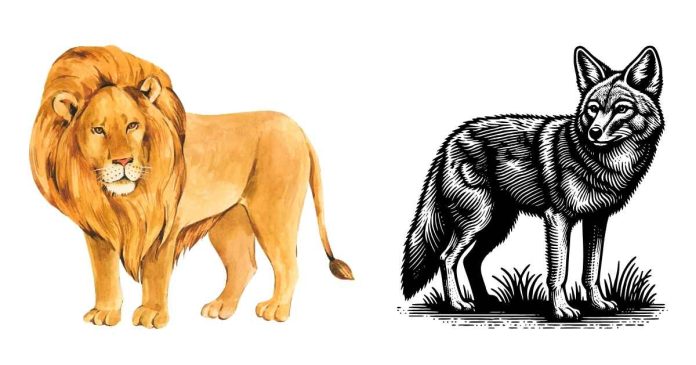Scavengers are animals that feed on the remains of dead animals, often those killed by predators or accidents. Several scavenger species are known to feed on mountain lions (Puma concolor) and coyotes (Canis latrans), although these predators are not easy prey due to their size, strength, and agility. However, certain scavengers, especially larger animals, are capable of consuming the carcasses of these predators. Below are some of the key scavengers that may eat mountain lions and coyotes:
1. Bears (Black Bears and Grizzly Bears)
- Black Bears (Ursus americanus) and Grizzly Bears (Ursus arctos) are powerful scavengers that are capable of consuming the remains of both mountain lions and coyotes.
- Behavior: Bears are opportunistic feeders and have a highly varied diet that includes plants, fruits, insects, small mammals, and the carcasses of large animals. They are also known to feed on carrion, including the remains of predators like mountain lions and coyotes.
- Why They Scavenge: Bears are large and strong, and they have an excellent sense of smell, which allows them to locate carcasses from long distances. Given that mountain lions and coyotes can be vulnerable when injured or sick, bears may take advantage of an opportunity to feed on their remains.
- Frequency: While it’s not common for bears to hunt mountain lions or coyotes, they will scavenge their carcasses if available, especially during times when food is scarce or if they come across an injured or dead predator.
2. Wolves (Canis lupus)
- Wolves are known scavengers and will often feed on the remains of other animals, including predators like coyotes and even mountain lions if they find a carcass.
- Behavior: Wolves live in packs and have strong cooperation in their social structure. While wolves are also skilled hunters, they will scavenge when the opportunity arises. They are known to steal kills from other predators, including mountain lions and coyotes.
- Interaction with Coyotes: Wolves may compete with coyotes for food, and in some cases, a pack of wolves may kill or scavenge a coyote, especially if the coyote is weak or sick. Wolves may not directly hunt healthy adult mountain lions, but in some rare cases, they may scavenge mountain lion carcasses when found.
- Frequency: In regions where wolves and mountain lions overlap, wolves may occasionally scavenge lion carcasses, particularly if the lions were injured, or if the wolves find an opportunity.
3. Vultures (Turkey Vultures and Black Vultures)
- Turkey Vultures (Cathartes aura) and Black Vultures (Coragyps atratus) are large scavenging birds that primarily feed on carrion.
- Behavior: Vultures are excellent at locating dead animals using their keen sense of smell and sight. They are often among the first scavengers to arrive at a carcass, including the remains of mountain lions or coyotes. Vultures will feed on the soft tissues and flesh of dead animals.
- Why They Scavenge: Vultures are specifically adapted for a scavenging lifestyle. They have a highly efficient digestive system that allows them to safely consume decaying meat, which many other animals would find dangerous due to bacteria and toxins.
- Frequency: Vultures often feed on the remains of a variety of animals, including large predators like mountain lions and coyotes, especially once the body has begun to decompose.
4. Cougars (Mountain Lions) Themselves
- In certain rare circumstances, mountain lions themselves can act as both predator and scavenger, particularly if they find an easy meal like a dead coyote or another animal.
- Behavior: Mountain lions are apex predators and often kill for food rather than scavenging. However, they will occasionally feed on the carcasses of other animals, especially if food is scarce or if the prey is already dead and easy to consume.
- Frequency: While mountain lions primarily hunt for themselves, they can sometimes take advantage of carcasses they encounter, including those of smaller predators like coyotes.
5. Other Scavengers
- Ravens and Coyotes (in some cases) are opportunistic feeders and may feed on the carcasses of mountain lions or coyotes, though they generally prefer smaller animals.
- Coyotes may occasionally scavenge from the remains of other coyotes, especially if they are in a weakened state, though they generally avoid larger predators like mountain lions unless the opportunity arises.
- Wild Boars: In some areas, wild boars are known to scavenge dead animals, including coyotes and mountain lions, especially in regions where they overlap with other carnivores.
Summary:
The two primary scavengers that are most likely to feed on mountain lions and coyotes are bears and wolves, due to their size, strength, and opportunistic feeding habits. Vultures are also significant scavengers, consuming the remains of these predators, especially once decomposition has set in. Other animals, such as ravens and wild boars, may scavenge smaller parts or carcasses in certain situations. The dynamics between these scavengers and their prey are shaped by factors like the availability of food, the health of the animals involved, and the specific ecological context of the region.


